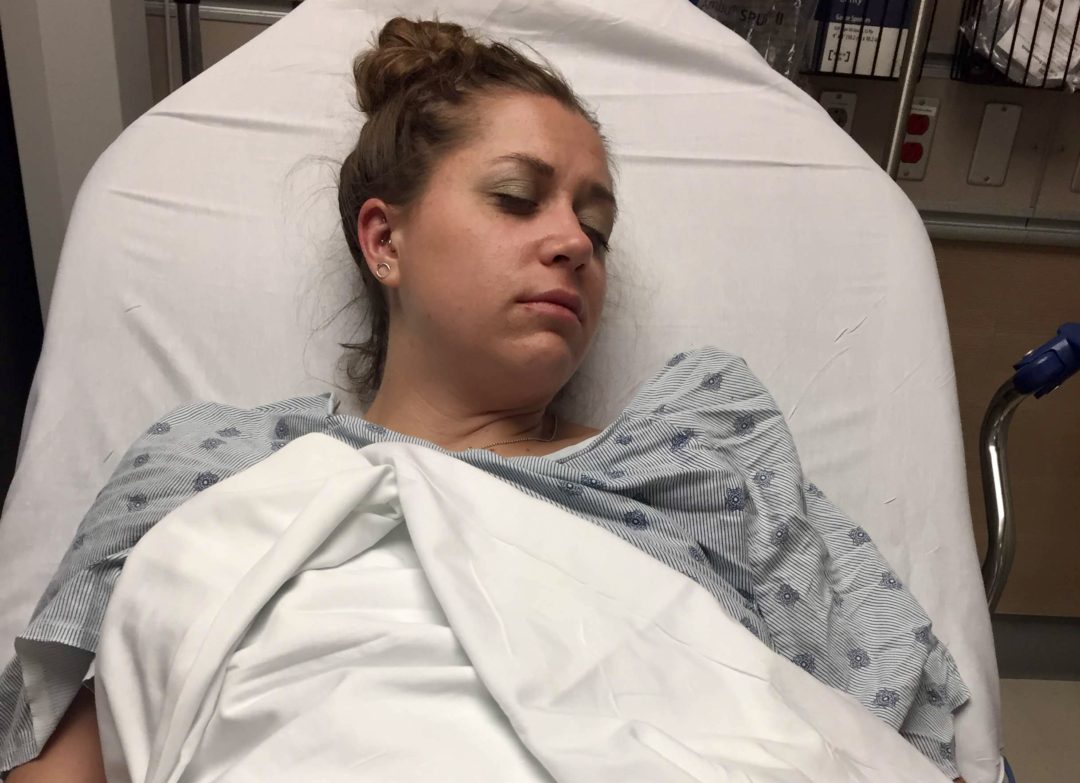My eight months post-type 1 diabetes diagnosis didn’t look glamorous. In fact, it looked something similar to searching for lifesaving hidden treasures alone in an infested cave while blindfolded and wearing noise-cancelling headphones. I had virtually no direction or guidance. Part 1 of this series described my slow decline leading up to the onset of autoimmune disease. Now, I’ll tell you about the post-diagnosis cascade.
My type 1 diagnosis came exactly 30 days after moving across New York City to a new Harlem apartment, 24 days after starting a new full-time job, and 20 days after my 32nd birthday. My entire life was in transition. And, in May 2016, a new chronic condition became an added adjustment. Despite feelings of instability, I felt a sense of relief with the diagnosis. Since I hadn’t felt like myself for a while, having answers seemed like hope and progress.
This relief only lasted a few months, however. I soon realized that autoimmune diseases aren’t often simple conditions. And, a broken pancreas wouldn’t be my only physical issue to manage.
I spent the summer of 2016 either sleeping or trying to maintain normalcy through lethargy and brain fog. My doctors repeatedly advised that my symptoms indicated an adjustment to more stable blood sugar levels. Sounds fair enough, I thought. So, I followed their orders and tried to push through.
I had entered a new phase of normalizing symptoms, only this time I did so under doctors’ orders.
At my three-month follow-up in August, doctors praised me for lowering my A1C from 11.1% to 7%. I recognized my progress, as a non-diabetic averages between 4% and 5.6%. Yet, as my lab results improved, my physical health continued to decline. I began to notice significant changes in my memory and cognitive abilities. I’m still adjusting to diabetes, I’d remind myself.
That September, I pulled myself out of work and moved temporarily home to Rochester to live with my parents. By this time, I struggled to keep up with basic tasks at work and home. Once, I nodded off in session with a client who attended court-mandated treatment with me for a heroin addiction. As illustrated by the ironic nodding off role reversal, clearly I was not okay.
Another time, I walked across a Harlem intersection in front of a moving ambulance. I didn’t even hear or see its blaring sirens a half block away. I do remember a man getting in my face and yelling, “What’s wrong with you, lady?” I wished I knew.
That November, I lost my balance and fell down a flight of stairs at my parents house. To this day, I have an indentation from the bruise the bottom step kissed onto my ass. Two days later, I landed in an emergency room after accidentally injecting 20 times my required insulin dosage while in a tired fog. This was the day I learned how dangerous insulin can be. I inhaled a jar of jelly and king-sized Hershey bar while my sister and now-brother-in-law carried me to the hospital. I spent the night drinking hospital orange juice while connected to glucose IV.
At my six-month check-up a few weeks later, my A1C was 5.6%. This data of stellar blood sugar levels became the first piece of leverage I had to convince doctors that my symptoms warranted more attention. Thus, a referral process began, and I felt another momentary wave of progress and relief.
I had more doctors’ visits than I could count over the next couple months. Yet, waiting for appointments and answers consumed my time. In addition to my ER stay, I visited an urgent care, my primary care doctor multiple times, a new endocrinologist, a new dentist for an onset of gum and jaw issues, an eye doctor to rule out damage from retinopathy, and a neurologist. I had an MRI of my head and got used to lots of poking and prodding from lab work. Time and time again I received praise for how perfect my test results looked.
“You’re doing such a great job!” the doctors would say. Yet, normal results began to feel maddening. I didn’t feel normal. To the contrary, I was becoming more dysfunctional by the day.
By Christmas, my physical symptoms had become more frequent and intense. Until this point, I could usually push my body and pretend to function when I needed to. Now, waves of dizziness and nausea began compromising my ability to drive and walk. I returned to Harlem to terminate my new apartment lease and, with the help of my now-husband, officially moved out of NYC.
I spent the following month in my childhood bedroom bedridden and at the mercy of my parents to cook meals, walk my dog, and drive me to and from doctors’ offices for continued testing. I’ll add a huge shoutout here to my newly retired parents for taking in and taking care of their newly dependent 32-year-old daughter.
By New Years Day, joint pain and muscle aches made it nearly impossible to comfortably move or sleep. My headaches, nausea and brain fog became chronic, and I’d frequently lose my train of thought mid-sentence. After a while, I couldn’t sit upright without experiencing a rapid heartbeat and difficulty breathing. I couldn’t walk the heal-to-toe exercise in my doctor’s office without falling over.
I became convinced that my issues were neurological and started counting the days until I could see a neurologist. After months on a wait list, I just knew he’d have answers for me. When I finally attended the appointment in mid-January 2017, I completed a 45-minute neurological evaluation and listened as the doctor gave me the “good news:” all my results looked normal.
The graying white man proceeded to educate me about anxiety – a condition I was personally certified to diagnose and treat. “This is why you’re having a hard time in grocery stores,” he explained, referencing my struggles to function in public. He went on to explain that my reported symptoms mimicked those of an elderly lady (my point exactly), and ended with a condescending pep talk about why I should not worry about my symptoms. “You’re young and healthy,” he said while gesturing his hands toward me to indicate how “good” I looked before writing me a prescription for Ativan.
Anger steamed beneath my brain fog as I tried desperately to articulate a defense against this misdiagnosis. I had spent 10 years traveling the world alone, embracing adventures like skydiving, moving to new cities by choice, and rafting the Nile River. I’ve been stopped at the Rwanda-Congo border by militia carrying AK-47s and chalked it up to another adventurous story to tell. As a mental health clinician, I’m open to and aware of what anxiety looks like. I knew this was not the cause of my symptoms. I also had no interest in taking a flippantly prescribed controlled substance.
I decided to shift gears after this neurologist left me with fire spewing out of my eyeballs. Conventional medicine wasn’t working for me, and he was the icing on my sugar-free cake.
A few weeks later, I had my first appointment with a homeopathic nurse practitioner. Within 15 minutes of meeting me, she identified intolerances to gluten and dairy, among several other vitamin deficiencies. Within one week of eliminating these foods and starting supplements, my energy began to return and, despite needing daily naps, I got back on my feet. A few months later, I felt better than I had in years.
My progress lasted until March of 2018 when my health took another nosedive. I’ll get into that in Part 3. For now, here are a few points about what I learned during this phase of my health journey:
- Healthcare has a direct line to politics in the U.S. Instead of being considered a human right, access and affordability depend on privileges like employment and marriage. Keep a lookout for an upcoming post about how Obamacare saved my life.
- We must be our own health advocates. Our healthcare system is designed to manage acute issues like broken arms and cut fingers. It’s not set up to take a holistic, whole-person approach to our wellbeing. This is not a jab at doctors. It’s the way the system is structured. It’s also why I kept slipping through the cracks.
- Diabetes and nutritional intolerances taught me the value in seeing food as medicine. After learning to calculate through every single crumb that I put into my body, I shifted into a more conscious and intentional lifestyle based on what my body wants and needs. This, in turn, helps me feel more balanced physically and mentally.
In Part 1 of this series, I identified many beginnings on my journey with autoimmune disease. This phase marked my widening knowledge of the gaps in our healthcare system. It kicked off a 13-month hiatus of feeling healthier than I had in years, despite my sadness around no longer being able to eat Wegmans’ rosemary bread. Most importantly, I began tuning into my body in a way I never otherwise would have. And, what a beautifully rich experience that has been.





7 Comments
Loving the written journey, Sara. Although much of it was traveled with you, it is through these posts that I am understanding it more deeply. Love, Mom
Thanking for being so vulnerable and sharing your journey. I look forward to part 3 and beyond.
Just a comment on the format… I like the takeaway bullets at the end — a favor for the reader! Not to sound like one of your doctor’s during your misdiagnosis journey, but great job on that 🙂
We can no longer afford to accept the misdiagnosed protocols necessary to be covered by our health insurance. We have to step in where doctors have been blinded to a one size fits all diagnosis. I am very glad that you got daggers in your eyes, pulled them out, and fought back with them in trailblazing your healing as painful and frustrating and out of body as it was. Allopathic medicine serves a purpose to a point but God provides medicine in our food and natural resources. Thank you for sharing to hopefully help others and to reflect on what you’ve come out of and where you are still going. I love you my brave beautiful niece!❤️
Lovely writing Sara. Your strength and fortitude clearly have helped you push through the turbulence. The details of your journey are much clearer to me in these posts. Keep up the fight and continue to educate others with your next chapters.
[…] This post is Part 1 of the series, My Autoimmune Journey. Check out Part 2 here. […]
[…] my body embraced a gluten-free, dairy-free diet in February 2017, I entered spring in the same way our New York weather does – by emerging from the dark, […]